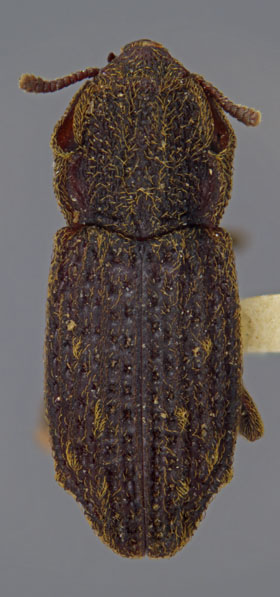 |
 Previous Genus Next Genus Previous Genus Next Genus 
Genus: Usechus
Diagnostic Features
- Description: Antennae 11-segmented with a 3-segmented club. Antennal setation sparse. Subantennal grooves absent. Eyes well-developed, elongate-oval, somewhat reniform, coarsely faceted, extending well onto dorsal portion of head. Submentum in male with a setose pit. Pronotum with anterolateral antennal cavities/grooves located above lateral margin, clearly visible from above. Pronotum narrowed anteriorly, distinctly margined laterally. Pronotal disc distinctly setose. Procoxal cavities closed. Metacoxae widely separated, separation as wide as metacoxal length. Abdominal ventrite 5 with a thin preapical groove. Tarsal formula 5-5-4. Dorsal surface with patches of short, thick, pale setae. Dorsal and ventral surfaces commonly encrusted with dirt and debris.
- Similar genera: The genus Usechus is similar to the genus Usechimorpha. Usechus can be readily distinguished by the less compact antennal club, closed procoxal cavities, distinctly widened apex of the prosternal process, and posterolateral depressions of pronotum not connected by a transverse groove at base. In Usechimorpha, the antennal club is more abrupt and compact, procoxal cavities are open, the apex of the prosternal process is truncate, and the posterolateral depressions of pronotum are connected by a transverse groove at base.
Known Distribution
- Northwest (OR, WA), Southwest (CA) USA.
Biology
- Usechus has been collected sifting leaf litter and detritus of oaks, maples and conifers. Usechus lacerta larvae and pupae have been collected in Quercus and associated with fungus under bark of dead maple (Acer macrophyllum) (Doyen and Lawrence, 1979).
- Abundance: Moderately rare.
North American Species (2)
Species Diagnoses
- Usechus lacerta: Elytral intervals 1, 3, and 5 merge at elytral base to form a transverse carina that does not project forward. Pronotum more uniformly setose except for glabrous posterolateral depressions. Distribution: California, USA.
- Usechus nucleatus: Elytral intervals 1, 3, and 5 merge at elytral base to form an abruptly raised tubercle that projects forward. Pronotum less uniformly setose, with larger glabrous posterolateral depressions and a glabrous mediobasal depression. Distribution: California, Oregon, Washington, USA.
Discussion
- Blaisdell (1929) divided the genus Usechus into two species, U. nucleatus and U. lacerta. He further divided U. lacerta into 4 varieties (U. lacerta lacerta, U. l. santaclarae, U. l. horni, and U. l. trinitatis). For the purposes of this work, all Usechus lacerta varieties will be treated under one species.
Potential Problems with Identification
- Members of this genus are frequently encrusted with dirt and other debris which may conceal the diagnostic characters.
Selected References
|
 |
 
Usechus lacerta
© N.P. Lord |
© 2011-2015 Lord, N.P., Nearns, E.H., and K.B. Miller
The University of New Mexico and Center for Plant Health Science and Technology, USDA, APHIS, PPQ.
|


